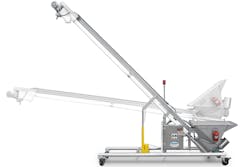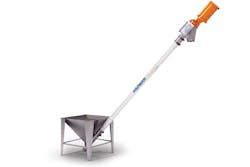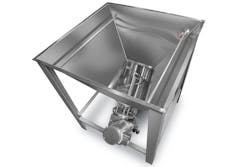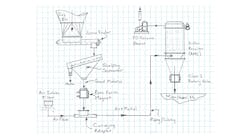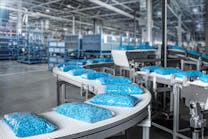Flexible screw conveyor customization
For decades, companies operating within the industrial and manufacturing sectors have been ardent users of screw conveying and feeding systems as part of their material handling processes. Flexible screw conveyors in particular are one of the most common types of equipment found in these production facilities. This is largely due to their relatively low cost and simple construction; the screw or auger is the only part of the conveyor that moves, and the only other major components are the tubular housing and the electric motor that drives the screw.
Other attractive aspects of this equipment include its versatility, flexibility and ability to be customized. But while flexible screw conveyors offer a reliable, straightforward method of moving powders and several other types of materials, there is no one-size-fits-all approach. The distinct makeup of materials will present unique characteristics and challenges that must be addressed by how a conveyor is constructed and configured to handle a particular product. This requires in-depth analysis of the material’s size, shape, weight and tactile characteristics that impact its ability to be moved effectively. Ambient temperature, harsh surrounding environments and the length and angle of the conveyor’s full run must be taken into account as well.
With any number of variables potentially impacting the material handling performance of a flexible screw conveyor, it is important to understand how each component of the system can address these challenges. It is also critical to consider how the conveyor might affect the material, and vice versa. In powder handling applications, the end-users must not overlook important factors that could potentially lead to poor performance, excessive power usage, severe wear, material degradation and more problematic consequences.
All of these factors can be extremely detrimental to an operation’s bottom line, and all of them can be mitigated by selecting custom component options that are designed for conveying powders — starting with the screw itself.
A center core restricts the amount of space within the conveyor, which reduces the load imposed on the screw by very dense or highly aerated/fluidized powders.
Flat wire augers are made of rectangular or square wire and typically deliver the best results possible from a flexible screw conveyor when handling powders and other light materials. The flat conveying surface applies a more positive forward directional force on the product being conveyed and reduces the outward force against the tube wall, resulting in greater efficiency with less degradation.
Beveled wire augers are used for product that has a tendency to build up on surfaces (such as TiO₂ and many other oxides).
Center cores are small tubes placed in the center of the screw that extend the full length of the auger. The center core restricts the amount of space within the conveyor by reducing the amount of material delivered through the equipment, which in turn reduces the load imposed on the screw. Use of a center core is recommended when conveying very dense or highly aerated/fluidized powders.
Ribbon and pin agitators promote the flow of high-moisture, sluggish and other difficult-to-handle powders through a process to maintain desired production levels. They also eliminate the potential for product to bridge in the hopper.
Vibratory hoppers and other special hopper designs also promote material flow by introducing intermittent vibration to a process. Additionally, they offer their own assortment of options to make moving material more efficient: standard and custom sizes ranging from 8 ft3 (2.4 m3) to more than 100 ft3 (30.5 m3), 304 or 316 stainless steel construction, flanged inlets and more.
Hopper-mounted air pads force air along the hopper wall, fluidizing the material for optimal conveying.
Optional mobile bases provide a discharge height of 12 ft (3.66 m) and allow a flexible screw conveyor to be relocated and repurposed throughout a plant, eliminating equipment redundancy and reducing capital expenditures.
While flexible screw conveyors offer a reliable, straightforward method of moving powders and several other types of materials, there is no one-size-fits-all approach.
Other operational considerations
Once the correct equipment options are in place, several other operational considerations will affect the performance of a flexible screw conveyor.
With the exception of initial charging and emptying, flexible screw conveyors should never be run empty for extended periods of time unless they are specifically engineered to do so. Allowing the conveyor to run without material in the hopper causes excessive fatigue on the system’s components. To mitigate this potential problem, sensors at the pickup point can automatically shut off the conveyor when material is not present.
Dry operations occur when a flexible screw conveyor has been running fully loaded — or at a high fill percentage — and is then no longer given material to convey. This typically happens in applications where increased slippage, visual material rollback and a steady decrease in output occurs. A conveyor can be designed to run under these conditions by utilizing the proper outer tube and screws in combination with slower rpm levels, which help keep the inlet hopper full. Once the hopper is empty, the product will struggle to elevate due to the lack of load on the screw.
Hoppers offer their own assortment of options to make moving powders more efficient: standard and custom sizes, 304 or 316 stainless steel construction, flanged inlets and more.
Employing a Hi/Lo or tilt-style flexible screw conveyor is another option that is ideal for applications where total evacuation of conveyed materials is critical. The Hi/Lo allows the operator to lower the conveyor to a horizontal position, empty out any remaining residual product and fully remove the screw. Washdowns, cleanouts, auger changeovers and regular maintenance are all greatly simplified with improved results. Another benefit of using the Hi/Lo option is that operators can clean and disassemble the conveyor safely on the floor in just minutes without the use of lifts or ladders.
Flexible screw conveyors can also be customized to conform to the specific mode of operation they will be performing such as the following:
Batch operation — This is the easiest of all duties. When only one material is batched, it is relatively easy to maximize batch output so that residual product is left in the conveyor to maximize its repeatability. The residual product remains should be considered, since they may contain various ingredients that may not completely transfer from the system as desired. By first introducing a portion of the larger, major ingredients, followed by the smaller, minor ingredients, and then dumping in the remaining portion of the initial major ingredient, you can minimize loss. This is just one method of batching when exact weighment is not critical.
Intermittent operation — During this process, the conveyor starts and stops in a repetitive fashion under full load. Be aware that some heavy materials may cause startup issues. To mitigate this problem, special modifications can be made to the conveyor that will add to its structural strength and/or reduce the amount of material during startup.
Continuous operation — Flexible screw conveyors that perform nonstop for extended intervals need to be specifically designed for this type of operation and should be sized to run at an average speed range.
Flat wire augers typically deliver the best results possible from a flexible screw conveyor when handling powders and other light materials.
It is important to keep in mind that during standard operation, all flexible screw conveyors will leave residual material in the inlet tube once the hopper is empty. This material can be extracted by removing the end cleanout cap at the bottom of the conveyor and reversing the rotation of the screw, allowing for quick evacuation. Further cleaning can be performed with air, water or solvents with or without disassembly of the unit. If more maintenance is required, the outer tube and/or flexible screw can be removed and thoroughly cleaned. It can be difficult to keep up with the nuances of the various types of material handling equipment in a plant, but a complete planned preventive maintenance (PPM) schedule should be established for all operational systems to ensure optimal output and maintain desired production levels.
Conclusion
Given the different material characteristics and operational variables in a specific operation that uses flexible screw conveyors in its process, having many equipment options available is the key to achieving maximum efficiency and profitability. Today’s flexible screw conveyors are engineered to meet all standard expectations while offering the precision and custom flexibility to handle any powder handling needs. Partnering with an equipment provider that has decades of experience with this type of conveyor is the best way to select the correct options for a particular application.
Mike Zeluff is a product specialist at Kalamazoo, Michigan-based Hapman where he has been for more than 22 years. A graduate of Grand Valley State University, he has experience as a product specialist for Helix flexible screw conveyors as well as several other disciplines, including lab management, product testing and regional sales.
